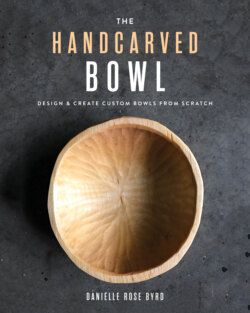Читать книгу The Handcarved Bowl - Danielle Rose Byrd - Страница 30
На сайте Литреса книга снята с продажи.
Оглавление30
T H E H A N D C A R V E D B O W L
Chapter 2 | T O O L S
MAKE YOUR OWN MAUL
When presented with a knotted log, don’t despair that it can’t be used for a bowl; celebrate
because you’ve just met your new maul. The reason you couldn’t bear to wrestle with it one more
second is the very reason it’s useful for hitting things. If all you have is a clear grain blank, that
will work too, but it won’t last nearly as long.
LENGTH & WEIGHT
The most-knotted section should be the part used for
hitting. Hopefully the other end is mostly free from knots
to more easily shape the handle. I aim to make my mauls
with heads as big as possible while still being able to swing
it with a moderate amount of control. Swinging a maul
isn’t like swinging a hammer; it’s more like raising it up and
encouraging a directed fall. You want the weight of the
head to work to your advantage. The length of the head
varies depending on the size of the small log or portion of
wood used. I usually aim for a head about 6" to 8" long. If
it’s too heavy, you can always trim this down.
Begin by using a bow saw or a similar coarse-toothed
saw to cut a line around the maul where the handle ends
and the head of the maul begins. The depth of your cut
dictates the diameter of the handle.
Prop the maul on end, with the head on the chopping
block (haha!). Take a froe and your old maul or a heavy
mallet and work your way around the handle, taking off
small sections. With straight-grained material, the wood
will split all the way down to your saw line and fall away. If
it doesn’t easily break off, you probably need to saw a bit
deeper. Be conservative with this, though, so you don’t
make this point between the handle and head too thin and
weak. If using a gnarled root or burl, the froe step should
be skipped. All of that material will have to be axed away
because the grain won’t break consistently or easily.
SHAPE THE HANDLE
Shape the handle with an axe, but be careful not to plunge
the edge of the axe into the head of the maul. If the head
of the maul has straight grain, any errant blows could
chop off an entire section of the maul head. Another
method is to put the maul in a clamp or vise and shape
it with a drawknife.
It is also possible to forgo using a saw to create the
handle and just use an axe or drawknife to create a taper
that reduces to a shaped handle.
